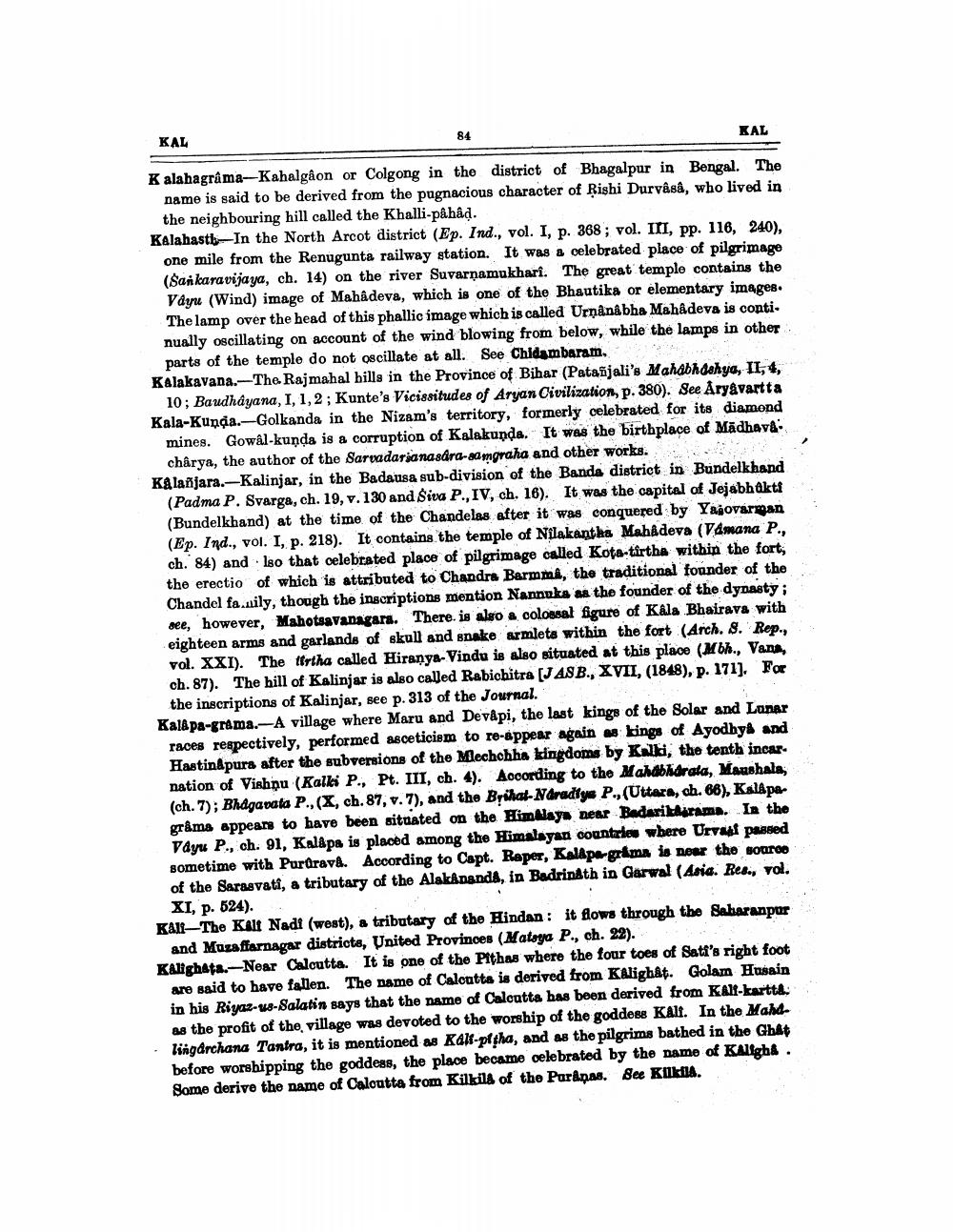________________
KAL
84
KAL
Kalahagrâma-Kahalgaon or Colgong in the district of Bhagalpur in Bengal. The
name is said to be derived from the pugnacious character of Rishi Durvâsâ, who lived in the neighbouring hill called the Khalli-påhâd. Kalahasti-In the North Arcot district (Ep. Ind., vol. I, p. 368; vol. III, pp. 116, 240), one mile from the Renugunta railway station. It was a celebrated place of pilgrimage (Sankara vijaya, ch. 14) on the river Suvarnamukhari. The great temple contains the Vayu (Wind) image of Mahadeva, which is one of the Bhautika or elementary images. The lamp over the head of this phallic image which is called Urnanâbha Mahadeva is conti. nually oscillating on account of the wind blowing from below, while the lamps in other
parts of the temple do not oscillate at all. See Chidambaram, KAlakavana.-The Rajmahal bills in the Province of Bihar (Patañjali's Mahabhdehya. II, 4.
10: Baudhayana, I, 1,2 ; Kunte's Vicissitudes of Aryan Civilization, p. 380). See Aryavartta Kala-Kunga.-Golkanda in the Nizam's territory, formerly celebrated for its diamond mines. Gowâl-kunda is a corruption of Kalakunda. It was the birthplace of Madhava
chârya, the author of the Sarwadarianasdra-samgraha and other works. Kalañjara.–Kalinjar, in the Badausa sub-division of the Banda district in Bundelkhand
(Padma P. Svarga, ch. 19, v. 130 and Siva P., IV, ch. 16). It was the capital of Jejabhakti (Bundelkhand) at the time of the Chandelas after it was conquered by Yagovarman (Ep. Ind., vol. I, p. 218). It contains the temple of Nilakantha Mahadeva (Vamana P., ch. 84) and lso that celebrated place of pilgrimage called Kota-tirtha within the fort, the erectio of which is attributed to Chandra Barmmah, the traditional founder of the Chandel family, though the inscriptions mention Nannuks as the founder of the dynasty; see, however, Mahotsavanagara. There is also a colossal figure of Kala Bhairava with eighteen arms and garlands of skull and snake armlets within the fort (Arch. 8. Rep., vol. XXI). The tirtha called Hiranya-Vinda is also situated at this place (Mbh., Vana, ch. 87). The hill of Kalinjar is also called Rabichitra (JASB., XVII, (1848), p. 171). For
the inscriptions of Kalinjar, see p. 313 of the Journal Kalapa-grama.-A village where Maru and Devâpi, the last kings of the Solar and Lunar
races respectively, performed asceticism to re-appear again as kings of Ayodhya and Hastinapurs after the subversions of the Mechchha kingdoms by Kalki, the tenth incar. nation of Vishnu (Kalli P., Pt. III, ch. 4). According to the Mahabhidrata, Maushals, (ch. 7); Bhagavata P.,(X, ch.87, v. 7), and the Brihal-Naradiye P., (Uttara, sh. 66), Kalapa grâms appears to have been situated on the Himalaya near Badarile arama. In the Vayu P., ch. 91, Kalápa is placed among the Himalayan countries where Urvm passed sometime with Purtravå. According to Capt. Raper, Kalapegrims is near the source of the Sarasvati, a tributary of the AlakAnandA, in Badrinath in Garwal (Asia. Res., vol.
XI, p. 524). Kan—The Kalt Nadi (west), a tributary of the Hindan: it flows through the Saharanpur
and Muzaffarnagar districts, United Provinces (Matsya P., ch. 22). Kalighata.-Near Calcutta. It is one of the Pithas where the four toes of Sati's right foot
are said to have fallen. The name of Calcutta is derived from KAligbåt. Golam Husain in his Riyaz-us-Salatin says that the name of Calcutta has been derived from KA-kartta as the profit of the village was devoted to the worship of the goddess Kalf. In the Mahdlingarchana Tantra, it is mentioned as Kali-pftha, and as the pilgrims bathed in the Ghat before worshipping the goddess, the place became oelebrated by the name of Kaligh& . Some derive the name of Calcutta from Kilkild of the Parkņas. See kiikta.




